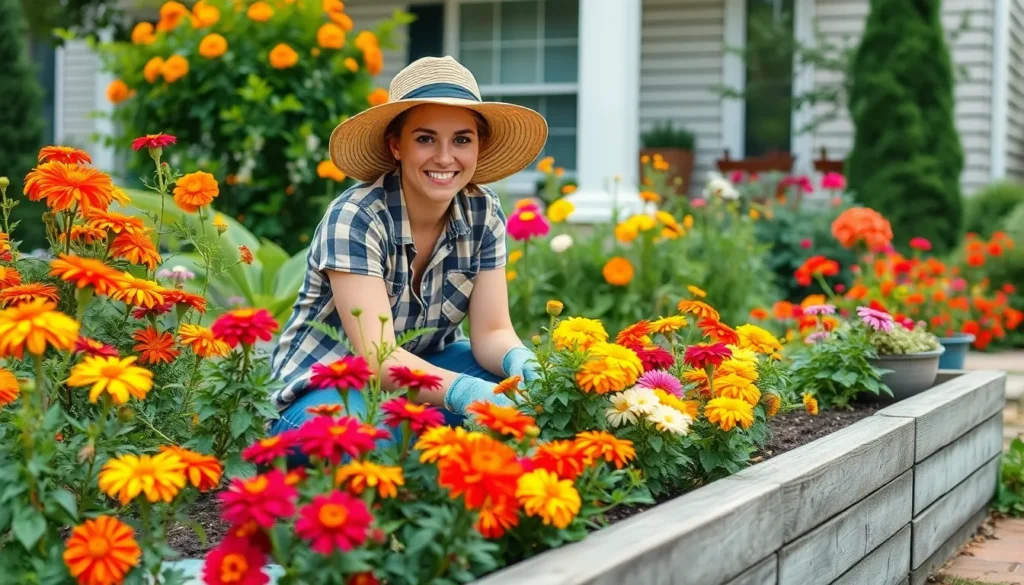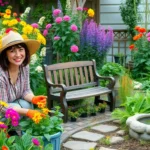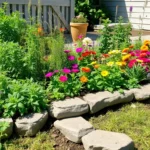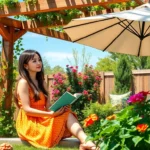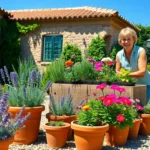Your front yard is the first thing guests see when they visit your home, and we believe it should make a stunning impression. Creating a beautiful flower garden doesn’t have to be overwhelming or expensive – with the right planning and plant choices, you can transform your front yard into a welcoming masterpiece that boosts your home’s curb appeal and property value.
We’ve discovered that successful front yard flower gardens combine seasonal blooms, strategic color placement, and low-maintenance varieties that thrive in your exact climate. Whether you’re working with a small strip along your walkway or a sprawling front lawn, the key is choosing flowers that complement your home’s architecture while providing year-round visual interest.
From vibrant annuals that deliver instant color to perennial favorites that return each spring, we’ll show you how to design a front yard flower garden that becomes the envy of your neighborhood while staying within your budget and maintenance preferences.
Create a Welcoming Entrance With Colorful Annual Flower Beds
Annual flowers deliver the quickest transformation for your front yard entrance, blooming continuously from spring through fall. These vibrant garden additions create an immediate wow factor that welcomes guests while boosting your home’s curb appeal.
Choose Fast-Growing Annuals for Instant Impact
Fast-growing annuals like marigolds, zinnias, and petunias establish themselves within weeks of planting. Marigolds reach full bloom in just 45-50 days from seed, producing bright orange, yellow, and red flowers that last until the first frost. Zinnias offer spectacular color variety including pink, purple, white, and coral blooms that attract butterflies throughout the growing season.
Petunias provide continuous flowering from late spring through fall, with wave varieties spreading up to 4 feet wide to fill large spaces quickly. Impatiens thrive in shadier areas near your entrance, producing delicate flowers in soft pastels that complement any home exterior. Sunflowers create dramatic focal points, with dwarf varieties like ‘Teddy Bear’ growing 2-3 feet tall while full-size varieties can reach 8-10 feet for maximum impact.
Cosmos germinate in just 7-10 days and produce daisy-like flowers in white, pink, and burgundy that self-seed for next year’s display. We recommend starting with transplants rather than seeds for the fastest results, allowing you to see immediate color transformation within days of installation.
Mix Heights and Textures for Visual Interest
Layering different plant heights creates depth and visual drama in your entrance flower beds. Position tall annuals like cleome, amaranth, and tall zinnias in the back row, reaching 3-5 feet to provide a colorful backdrop. Mid-height plants such as celosia, snapdragons, and medium marigolds work perfectly in the middle layer at 12-24 inches tall.
Edge your beds with low-growing annuals including alyssum, lobelia, and compact petunias that stay under 12 inches to define borders cleanly. Spiky textures from plants like salvia and celosia contrast beautifully with rounded blooms from asters and globe amaranth. Feathery foliage from dusty miller or coleus adds silver and burgundy tones that make bright flower colors pop.
Dense, mounding plants like begonias create solid blocks of color, while airy flowers such as cosmos and bachelor’s buttons provide delicate movement in breezes. Broad-leafed caladiums offer tropical texture with heart-shaped leaves in pink, white, and green patterns that complement surrounding blooms. This strategic layering approach ensures your entrance garden looks professionally designed while maintaining easy maintenance access.
Plan for Seasonal Color Rotation
Planning seasonal rotations keeps your entrance looking fresh and colorful throughout the growing season. Spring plantings of cool-weather annuals like pansies, snapdragons, and sweet alyssum provide early color when temperatures range from 45-65°F. These hardy flowers often survive light frosts and bridge the gap between winter dormancy and summer heat.
Summer rotations feature heat-loving annuals such as vinca, portulaca, and pentas that thrive in temperatures above 70°F and continue blooming through intense heat. Fall transitions bring opportunities for mums, ornamental kale, and asters that provide autumn colors in bronze, deep red, and purple tones. Cool-season vegetables like ornamental peppers and colorful chard also work as striking annual additions.
Succession planting every 2-3 weeks with the same varieties extends bloom time and prevents gaps in your display. We suggest dedicating 30% of your bed space to rotating seasonal annuals while maintaining 70% with reliable, long-blooming varieties. This rotation strategy ensures continuous color from April through November in most climates while allowing you to experiment with new varieties each season.
Design a Low-Maintenance Perennial Border Garden

Creating a perennial border garden transforms your front yard into a stunning display that returns year after year with minimal effort. We’ll focus on building a sustainable foundation that thrives with smart plant choices and strategic design principles.
Select Native Perennials for Your Climate Zone
Native perennials form the backbone of any successful low-maintenance garden because they’re naturally adapted to your local growing conditions. These plants require less water, fertilizer, and pest control since they’ve evolved to thrive in your exact environment.
For warm climates, we recommend incorporating:
- Hibiscus for dramatic tropical blooms
- Birds of paradise for exotic architectural interest
- Orchids for delicate seasonal color
For cooler climates, excellent choices include:
- Hydrangeas for abundant summer blooms
- Azaleas for spring color bursts
- Coneflowers for long-lasting summer displays
Selecting plants suited to your hardiness zone ensures they’ll survive winter temperatures and return stronger each growing season. We suggest consulting your local extension office to identify the best native varieties for your exact region.
Arrange Plants by Blooming Seasons
Strategic seasonal planning creates continuous color throughout the growing season while maintaining the natural flow from our annual displays. Arranging perennials by bloom time ensures something’s always flowering in your border garden.
Spring bloomers provide the season’s first color:
- Peonies offer fragrant, full blooms in late spring
- Azaleas create stunning early season displays
Summer bloomers maintain vibrant color during peak growing season:
- Coneflowers deliver reliable purple, pink, and white blooms
- Black-eyed Susans provide cheerful yellow flowers
Fall bloomers extend the garden’s appeal into autumn:
- Asters produce clusters of small, colorful flowers
- Chrysanthemums add rich oranges, reds, and yellows
Overlapping bloom times creates seamless transitions between seasons while ensuring your front yard maintains visual interest from spring through fall.
Incorporate Evergreen Structure Plants
Evergreen shrubs and trees provide year-round backbone to your perennial border, maintaining visual interest even during winter months. These structural elements create permanent framework that supports seasonal flowering plants.
We recommend using plants with varying heights and textures to add depth and dimension to your garden design. Evergreen conifers like dwarf spruce or juniper provide vertical interest, while broadleaf evergreens such as boxwood or holly offer dense, sculptural forms.
Combining different evergreen textures creates visual contrast that enhances your flowering perennials. Ornamental grasses like fountain grass or feather reed grass add movement and softness, while bamboo creates dramatic vertical accents that require minimal maintenance.
Strategic placement of evergreen plants ensures your front yard flower garden maintains structure and appeal throughout all seasons, supporting the continuous blooming strategy we’ve established with our perennial selections.
Install Raised Flower Beds for Enhanced Curb Appeal
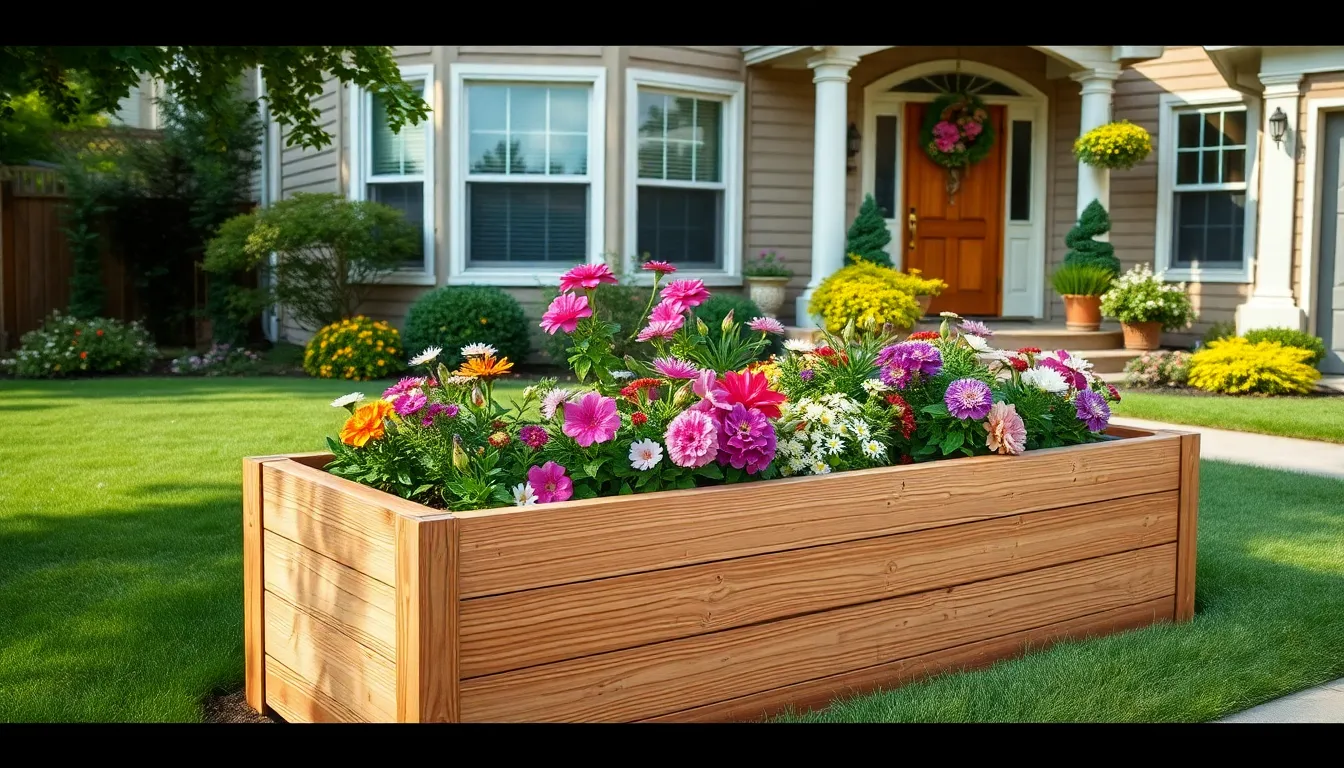
Raised flower beds create immediate visual structure while adding defined garden spaces that naturally boost your home’s curb appeal. Building these elevated planting areas gives you better control over soil quality and improves drainage for healthier plant growth.
Choose Materials That Complement Your Home’s Style
Wood materials offer a natural and rustic appearance that works beautifully with cottage or traditional home styles. Cedar and redwood provide excellent rot resistance, making them ideal long term choices for wooden raised beds.
Stone or brick creates a classic, durable look that perfectly complements traditional or colonial home architectures. These materials age gracefully and require minimal maintenance while providing lasting beauty.
Concrete or composite blocks deliver a modern and clean aesthetic that suits contemporary or minimalist house designs. Selecting materials that match or complement your home’s existing architecture enhances overall harmony and visual appeal.
Determine Optimal Height and Width Dimensions
Height measurements of 12 to 24 inches work ideally for raised flower beds to ensure proper drainage and healthy root development. These dimensions allow plants sufficient growing space while creating noticeable visual impact from street level.
Width planning should target 3 to 4 feet across so you can comfortably reach the center from both sides without stepping into the planting area. This measurement facilitates easy planting and ongoing maintenance while enabling clear garden visibility from your front entrance.
| Dimension | Recommended Size | Purpose |
|---|---|---|
| Height | 12-24 inches | Drainage and root growth |
| Width | 3-4 feet | Easy maintenance access |
| Visual Impact | Street level visibility | Enhanced curb appeal |
Plan Proper Drainage and Soil Preparation
Drainage holes or gaps must be incorporated into raised bed construction to prevent waterlogging that can damage plant roots. Proper water flow prevents root rot and promotes vigorous plant growth throughout the growing season.
High quality garden soil or a specialized mix of compost, peat moss, and vermiculite provides the fertility and moisture retention your flowers need to thrive. Quality soil preparation before planting creates the foundation for long term flower garden health and continuous blooming success.
Soil testing helps determine pH levels and nutrient needs exact to your chosen flower varieties. Preparing the growing medium well before installation supports healthy plant establishment and reduces future maintenance requirements.
Plant a Cottage-Style Garden for Romantic Charm
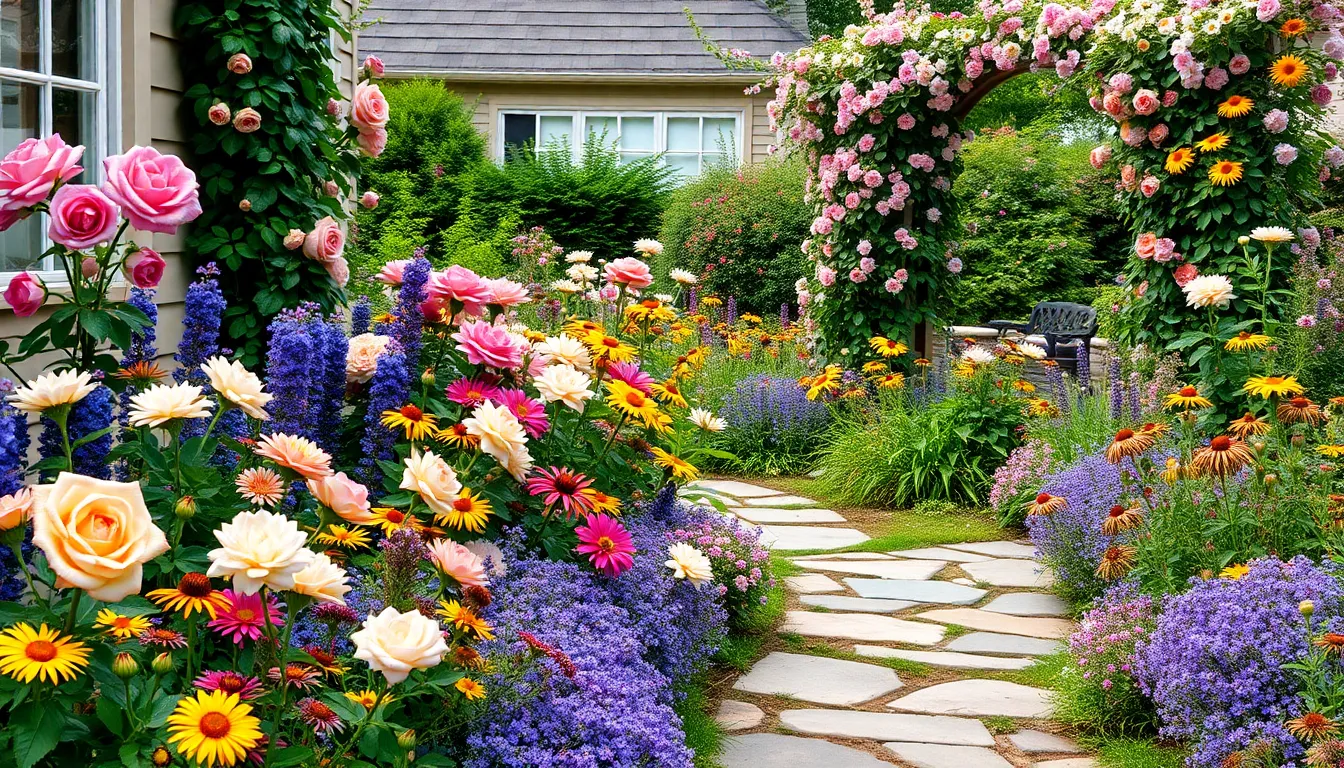
Cottage-style gardens bring romantic, informal charm to any front yard with their relaxed approach to flower arrangement. We’ll transform your entrance into a welcoming space that captures the timeless appeal of traditional English gardens.
Mix Traditional Cottage Garden Flowers
Traditional cottage garden flowers create the foundation for authentic romantic charm in your front yard design. Roses serve as the quintessential cottage garden staple, providing fragrant blooms and classic appeal throughout the growing season. Lavender adds aromatic qualities while attracting beneficial pollinators like bees and butterflies to your garden space.
Coneflowers deliver vibrant colors and exceptional drought tolerance, making them perfect for busy homeowners seeking beauty without constant maintenance. Perennials like peonies and daylilies return year after year, offering long-lasting blooms that justify their initial investment. Black-eyed Susans provide cheerful yellow flowers that brighten any cottage garden display from summer through early fall.
Annual additions like petunias and marigolds inject seasonal color pops that complement your established perennial plantings. These fast-growing options fill gaps between perennials while delivering continuous blooms throughout the growing season.
Create Natural, Informal Planting Patterns
Natural planting patterns distinguish cottage gardens from formal industry designs through their relaxed, spontaneous appearance. Layered planting techniques combine tall background plants with medium-height specimens and low-growing groundcovers to create visual depth and dimension.
Wildflower mixes scattered throughout your cottage garden add casual charm while supporting local wildlife populations. These native varieties require minimal care once established and self-seed for future seasons of natural beauty.
Stepping stone pathways wind through your cottage garden plantings, creating intimate walking experiences while protecting delicate flowers from foot traffic. Flagstone or brick materials complement the informal cottage aesthetic while providing practical access for garden maintenance tasks.
Add Climbing Plants for Vertical Interest
Climbing plants transform vertical surfaces into living art displays that maximize your front yard’s flowering potential. Climbing roses cascade over trellises, fences, and arbors to create romantic focal points that define your cottage garden’s character.
Clematis vines offer diverse bloom colors and flowering seasons, extending your garden’s visual appeal from spring through fall months. Morning glories provide quick coverage for unsightly structures while delivering trumpet-shaped flowers in vibrant blues and purples.
Wisteria creates dramatic displays with its cascading flower clusters, though proper pruning maintains its growth within desired boundaries. These climbing specimens add architectural interest while softening hard industry elements like walls and fences throughout your cottage garden design.
Establish a Modern Minimalist Flower Display
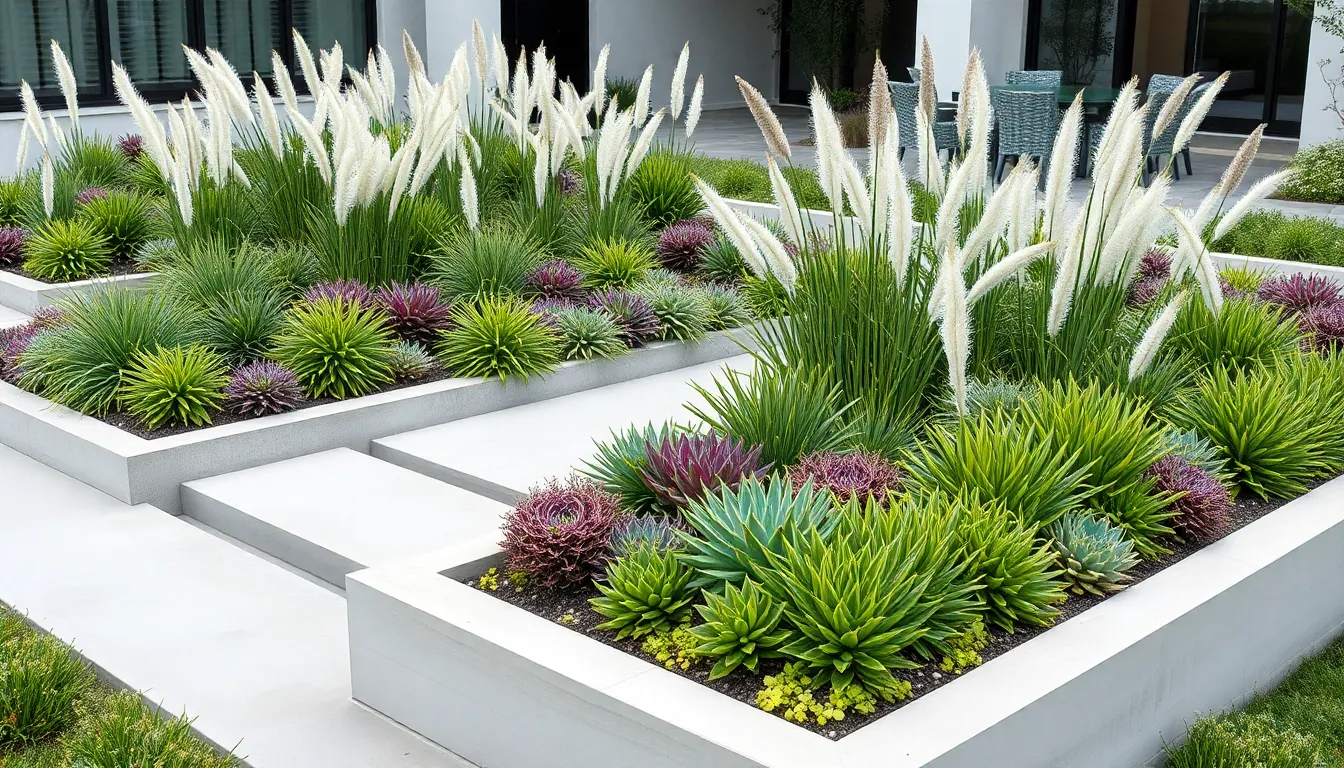
Moving beyond the romantic charm of cottage gardens, we can create sophisticated front yard displays that emphasize simplicity and clean design principles. Modern minimalist flower displays focus on structure, order, and carefully curated plant selections.
Select Plants With Clean Lines and Simple Forms
Choosing plants with simple forms and limited foliage creates a streamlined look that defines minimalist garden design. Ornamental grasses provide vertical structure without overwhelming visual complexity, while succulents offer geometric shapes and require minimal maintenance. Compact shrubs maintain their form throughout seasons, delivering consistent structure to the overall display.
Monochromatic color schemes enhance the minimalist aesthetic by reducing visual clutter and creating harmony. We recommend focusing on whites, purples, and greens to establish a cohesive palette that feels both sophisticated and calming. Plant selections should emphasize texture and form over abundant blooms, allowing each specimen to make a distinct architectural statement.
Limited plant varieties prevent the garden from appearing cluttered or chaotic. Select three to five plant types maximum, allowing generous spacing between each planting to emphasize individual specimens. This approach creates breathing room that’s essential to minimalist design principles.
Use Geometric Planting Patterns
Arranging plants in straight rows, grids, or concentric circles emphasizes order and precision that defines modern minimalist gardens. These structured patterns create visual rhythm and reinforce the architectural qualities of your front yard display. Geometric arrangements work particularly well with ornamental grasses and compact shrubs that maintain consistent shapes.
Grid patterns work best for rectangular planting areas, creating orderly displays that complement contemporary home architecture. Space plants at equal intervals to maintain the geometric integrity of the design. Row plantings suit narrow border areas along walkways or driveways, providing structure without overwhelming the space.
Circular arrangements add ever-changing interest while maintaining minimalist principles. Concentric circles work effectively with different plant heights, placing taller specimens in the center and shorter ones around the perimeter. This technique creates focal points that draw attention without disrupting the overall clean aesthetic.
Incorporate Contemporary Hardscape Elements
Adding raised planters and sleek pathways made of concrete or pavers reinforces the minimalist theme while improving functionality. Raised beds offer clean lines and make maintenance easier, while modern materials like steel and stone contribute to a polished appearance. These elements create structure that supports the overall design concept.
Edging materials define the boundaries of flower beds using metal, stone, or concrete to reinforce geometric themes. Clean edges prevent grass encroachment and maintain the precision that minimalist gardens require. Choose materials that complement your home’s exterior for visual continuity.
Architectural features like pared down pergolas or simple water features add interest without overwhelming the minimalist style. Energy efficient lighting or subtle solar features integrate functionality with contemporary aesthetics. Modular planters offer flexibility while maintaining the structured appearance essential to modern minimalist design.
Build Flower Boxes and Container Gardens
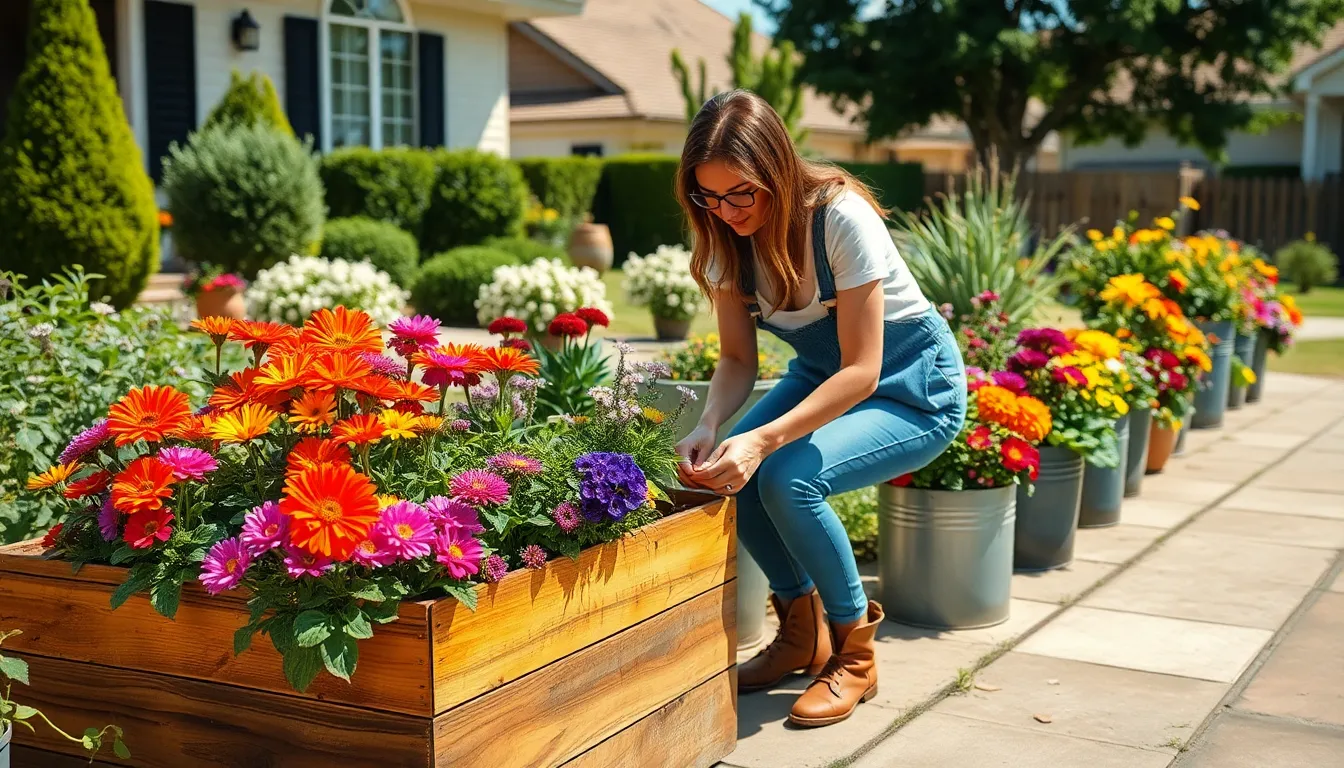
Container gardening offers flexibility and control over your front yard flower display while allowing you to move plants as needed for seasonal changes or weather protection.
Choose Weather-Resistant Container Materials
Weather-resistant materials ensure your flower boxes and containers last through multiple seasons while maintaining their appearance. Cedar wood provides natural weather resistance and complements traditional home styles with its warm, rustic appearance. Fiberglass containers offer exceptional durability against temperature fluctuations and won’t crack or fade like cheaper plastic alternatives.
Metal containers made from galvanized steel or aluminum withstand harsh weather conditions while adding a modern touch to contemporary landscapes. Recycled plastic options provide eco-friendly answers that resist moisture damage and won’t rot or warp over time. Stone and concrete planters deliver permanent answers that complement formal garden designs and handle extreme weather without deterioration.
Drainage becomes critical regardless of material choice, so we recommend containers with multiple drainage holes to prevent waterlogging and root rot. Elevating containers on pot feet or blocks improves air circulation and prevents water damage to patios and decks.
Select Appropriate Plant Combinations
Appropriate plant combinations create visual interest while ensuring all plants thrive in similar growing conditions. Cottagecore themes combine roses, peonies, and sweet peas for charming, romantic displays that bloom throughout the growing season. Tropical themes incorporate hibiscus, birds of paradise, and orchids to create lush, exotic appearances that make bold statements in warm climates.
Low-maintenance combinations feature succulents, ornamental grasses, and bamboo for tranquil rock gardens that require minimal care. Seasonal combinations allow for easy plant rotation, pairing spring bulbs like tulips and daffodils with cool-weather annuals for early color. Summer combinations mix heat-tolerant petunias, geraniums, and marigolds for continuous blooms through hot months.
Color coordination enhances visual impact, so we suggest monochromatic schemes using different shades of the same color family for sophisticated looks. Contrasting combinations pair complementary colors like purple and yellow for dramatic effects that catch attention from the street.
Plan for Proper Watering and Maintenance
Proper watering schedules prevent both drought stress and overwatering issues that commonly affect container plants. Research shows container plants dry out faster than ground-planted flowers, requiring more frequent watering during hot summer months. We recommend checking soil moisture daily by inserting your finger two inches deep into the potting mix.
Mulching around plants retains moisture and suppresses weeds while reducing watering frequency by up to 30%. Organic mulches like shredded bark or compost also improve soil quality as they decompose over time. Regular inspection for signs of disease or pests allows for early intervention and prevents problems from spreading to other plants.
Fertilizing container plants requires more attention than ground plantings since nutrients wash away with frequent watering. Slow-release fertilizers provide consistent nutrition for three to four months, while liquid fertilizers offer immediate results for struggling plants. Deadheading spent blooms encourages continued flowering and keeps plants looking neat throughout the growing season.
Create Seasonal Theme Gardens Throughout the Year
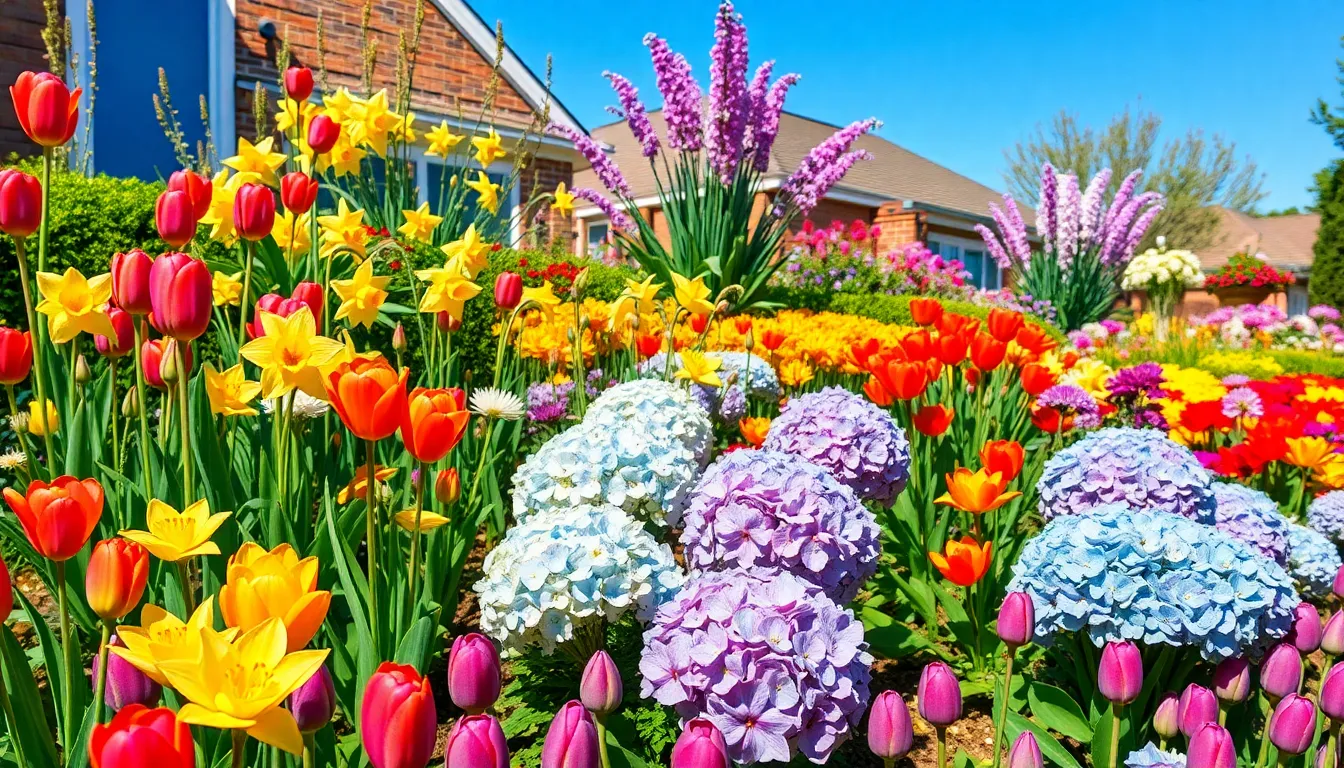
Transforming your front yard into a year round showcase requires strategic seasonal planning that ensures continuous color and visual interest. We’ll guide you through creating themed displays that transition seamlessly from spring’s vibrant awakening to winter’s elegant structure.
Design Spring Bulb Displays
Spring bulb displays create the foundation for your seasonal flower garden with early season color that emerges when landscapes are still dormant. Plant tulips, daffodils, and hyacinths in fall for spectacular spring blooms that provide vibrant colors when your garden needs them most. These bulbs require minimal care once established and return year after year with increasing abundance.
Layer your spring display by incorporating perennials like roses and coneflowers that begin blooming in late spring. This strategic timing creates a seamless transition from early bulb flowers to summer’s full growing season. Position taller perennials behind shorter bulbs to maximize visual impact and create depth in your planting design.
Combine different bulb varieties with staggered bloom times to extend your spring color display. Early bloomers like crocuses and snowdrops can start the season, followed by daffodils and tulips, then finishing with later varieties like alliums and fritillarias.
Plan Summer Heat-Tolerant Arrangements
Summer heat tolerant arrangements focus on plants that thrive in warm weather while providing continuous color throughout the hottest months. Use petunias, azaleas, and hydrangeas in window boxes or garden beds where they’ll receive adequate moisture and some protection during peak heat hours. These varieties maintain their blooms and foliage quality even when temperatures soar.
Incorporate climbing plants like climbing roses or bougainvillea on pergolas or trellises to add dramatic vertical interest. These vigorous growers create natural shade while producing abundant flowers throughout the summer season. Position them where they can receive morning sun but have some afternoon protection.
Select plants that complement each other’s water and light requirements to create efficient maintenance zones. Group drought tolerant varieties together and moisture loving plants in separate areas where you can provide targeted irrigation.
Incorporate Fall Color and Winter Interest
Fall color plants like asters, chrysanthemums, and sedum provide brilliant autumn displays that resist cooler temperatures while maintaining their vibrant appearance. These hardy perennials offer rich purples, golds, and burgundies that complement the changing season and bridge the gap between summer’s end and winter’s arrival.
Add seasonal decoratives like pumpkins and gourds to enhance your fall theme and create festive displays. These natural elements integrate seamlessly with your planted areas and can be refreshed throughout the autumn months.
Evergreen plants such as heuchera and viburnum provide essential winter interest with lasting color and texture that persists through cold weather. These reliable performers maintain garden structure when deciduous plants go dormant and serve as anchors for your seasonal displays.
Winter flowering plants like camellias and holly add unexpected color during the coldest months when most gardens appear barren. These specialized varieties bloom even though freezing temperatures and create focal points that draw attention to your garden’s year round appeal.
Add Fragrant Flowers for Sensory Appeal
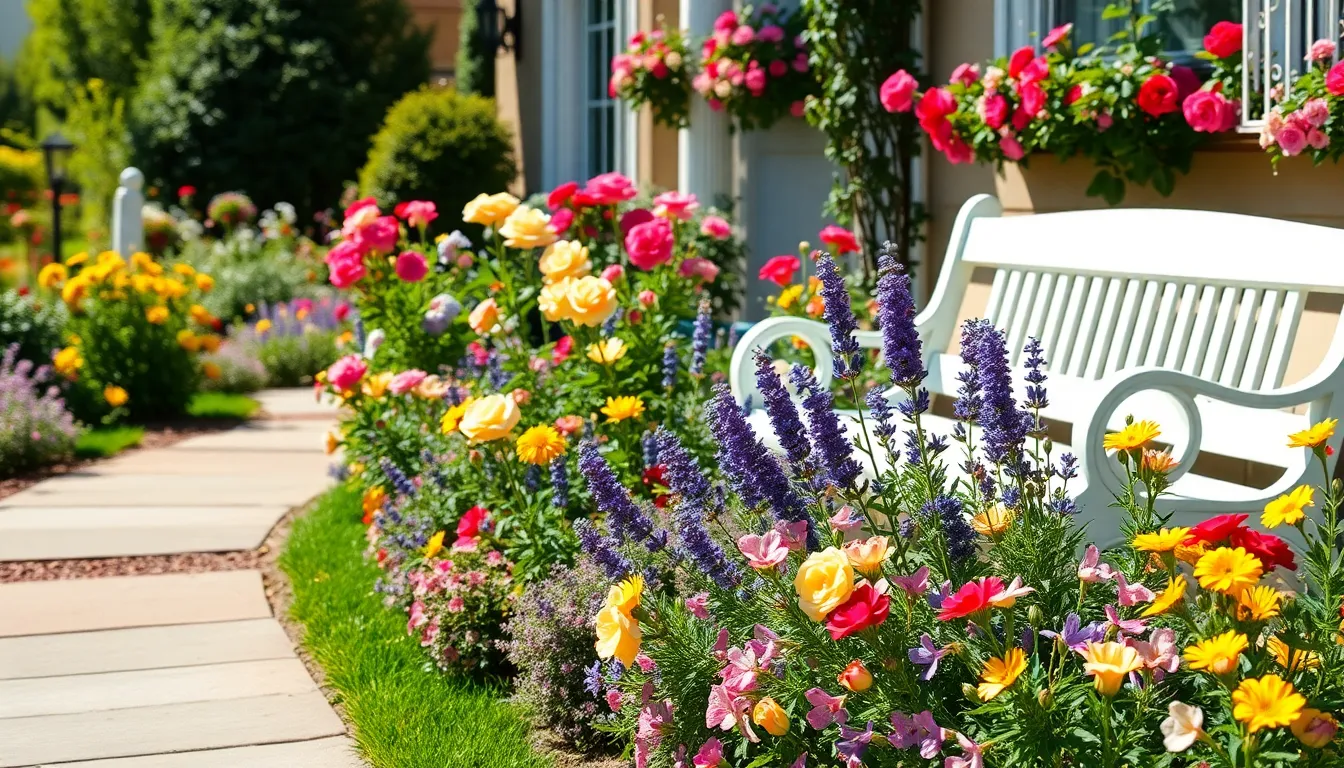
Building on seasonal themes and visual displays, we can enhance our front yard’s appeal by incorporating flowers that delight both the eyes and nose. Fragrant blooms transform a simple flower garden into a multi-sensory experience that welcomes visitors and creates lasting memories.
Choose Flowers With Pleasant Scents
Selecting flowers with natural fragrances creates an inviting atmosphere that draws people into your garden space. Roses offer classic elegance with their sweet, romantic scent that varies by variety, from light tea roses to intensely fragrant David Austin varieties. Lavender provides a calming, herbaceous aroma that’s both therapeutic and appealing to beneficial pollinators like bees and butterflies.
Sweet peas climb gracefully while releasing their delicate, honey-like fragrance that’s most pronounced in the evening hours. Gardenias deliver an intoxicating scent that can fill entire outdoor spaces with their creamy white blooms. Honeysuckle vines produce clusters of tubular flowers that emit their strongest fragrance at dusk, making them perfect for evening garden enjoyment.
Other excellent choices include jasmine for its exotic nighttime perfume, peonies for their fresh spring scent, and sweet alyssum for its subtle honey fragrance that works well as ground cover.
Position Fragrant Plants Near Walkways
Strategic placement of scented flowers maximizes their sensory impact by positioning them where people naturally walk and gather. Plant fragrant varieties along your main walkway to create a welcoming arrival experience for guests and family members. Position these flowers within 3 to 4 feet of paths to ensure their scents are easily detectable without overwhelming visitors.
Near your front entrance, create fragrant focal points using container gardens filled with aromatic herbs like rosemary or flowering plants like stock. Place seating areas adjacent to fragrant flower beds so you can enjoy the scents while relaxing outdoors. Install fragrant climbing plants on arbors or pergolas that frame walkways, creating natural tunnels of pleasant aromas.
Consider wind patterns when positioning fragrant plants, as gentle breezes carry scents more effectively than still air. Locate your most fragrant specimens where morning or evening breezes can distribute their perfumes throughout your outdoor living spaces.
Consider Bloom Times for Continuous Fragrance
Planning for sequential blooming ensures your garden maintains its aromatic appeal throughout the growing season. Early spring brings lilacs with their intense, nostalgic fragrance that signals winter’s end. Follow these with late spring bloomers like peonies and sweet peas that bridge the gap into summer’s heat.
Summer months benefit from jasmine’s evening perfume, roses at their peak fragrance, and night blooming flowers like four o’clocks that release scents after sunset. Late summer and fall extend the fragrant season with chrysanthemums, which offer a spicy, earthy scent, and late blooming roses that often produce their most concentrated fragrances in cooler weather.
Create fragrance layers by combining plants with different scent intensities and bloom times in the same planting area. Mix subtle fragrances like sweet alyssum with more powerful scents like gardenias to create complex aromatic experiences. Plant spring bulbs like hyacinths near summer annuals to ensure smooth transitions between fragrant seasons without gaps in your garden’s sensory appeal.
Incorporate Edible Flowers and Herbs
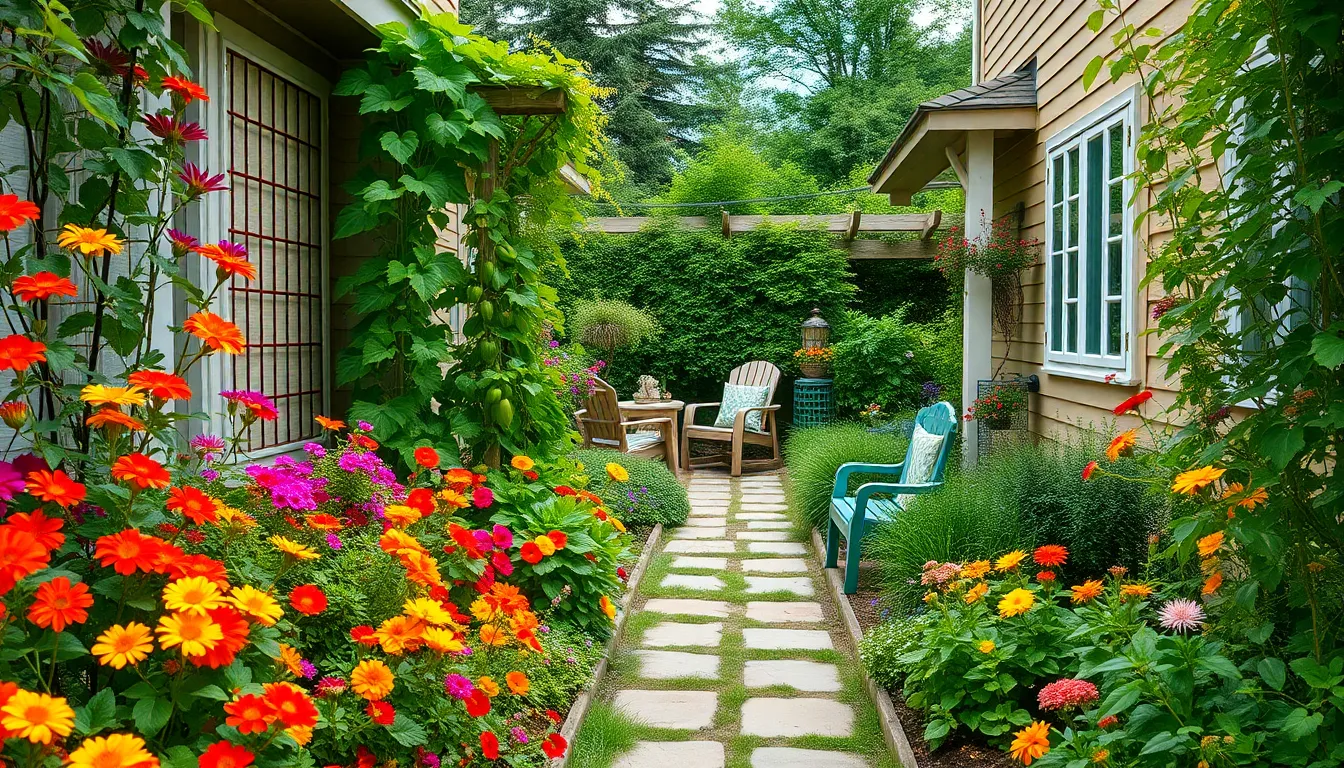
Building on the foundation of beautiful flower gardens, we can elevate our front yard design by incorporating plants that serve both aesthetic and culinary purposes.
Select Safe-to-Eat Flowering Plants
Nasturtiums offer vibrant colors while providing peppery blossoms that enhance salads and garnishes. We recommend these versatile flowers as essential additions to any edible garden because they’re both beautiful and flavorful.
Oregano flowers attract beneficial pollinators while delivering the same aromatic qualities as the leaves. These small, delicate blooms work perfectly in Mediterranean dishes and herb blends.
Rosemary flowers provide the same distinctive flavor profile as the plant’s needles. We can harvest these purple or blue blossoms to add Mediterranean flair to roasted vegetables and meat dishes.
Runner bean blossoms from varieties like Painted Lady create stunning vertical displays. These edible flowers taste excellent in soups and fresh salads while supporting climbing garden structures.
Combine Beauty With Functionality
Integrate fruits and vegetables strategically throughout flower beds to create diverse visual appeal. We suggest combining currants, raspberries, and strawberries with colorful vegetables like rainbow chard and paprika plants.
Mix ornamental flowers with edible varieties to ensure year round beauty. Dahlias and zinnias complement edible plants perfectly, providing continuous blooms when harvest seasons end.
Layer different textures by incorporating frilly carrot leaves alongside mounding pepper plants. This combination creates visual depth while maximizing our garden’s productive potential.
Install arbors and trellises to support climbing edibles like cucumbers and beans. These structures add vertical interest while creating functional growing space for vining crops.
Plan Harvest-Friendly Garden Layout
Design accessible pathways throughout the garden to reach all planting areas easily. We need clear routes for regular harvesting and maintenance without disturbing surrounding plants.
Create strategic patios near high-maintenance edible areas for comfortable harvesting sessions. These spaces provide convenient staging areas for garden tools and harvest containers.
Position frequently harvested plants closest to main walkways and entrances. Herbs and cutting flowers should remain within easy reach for daily use in cooking and arrangements.
Establish dedicated garden beds with proper spacing between plants for air circulation and growth. We recommend leaving adequate room for mature plant sizes while maintaining visual harmony throughout the industry.
Design for Wildlife-Friendly Flower Gardens
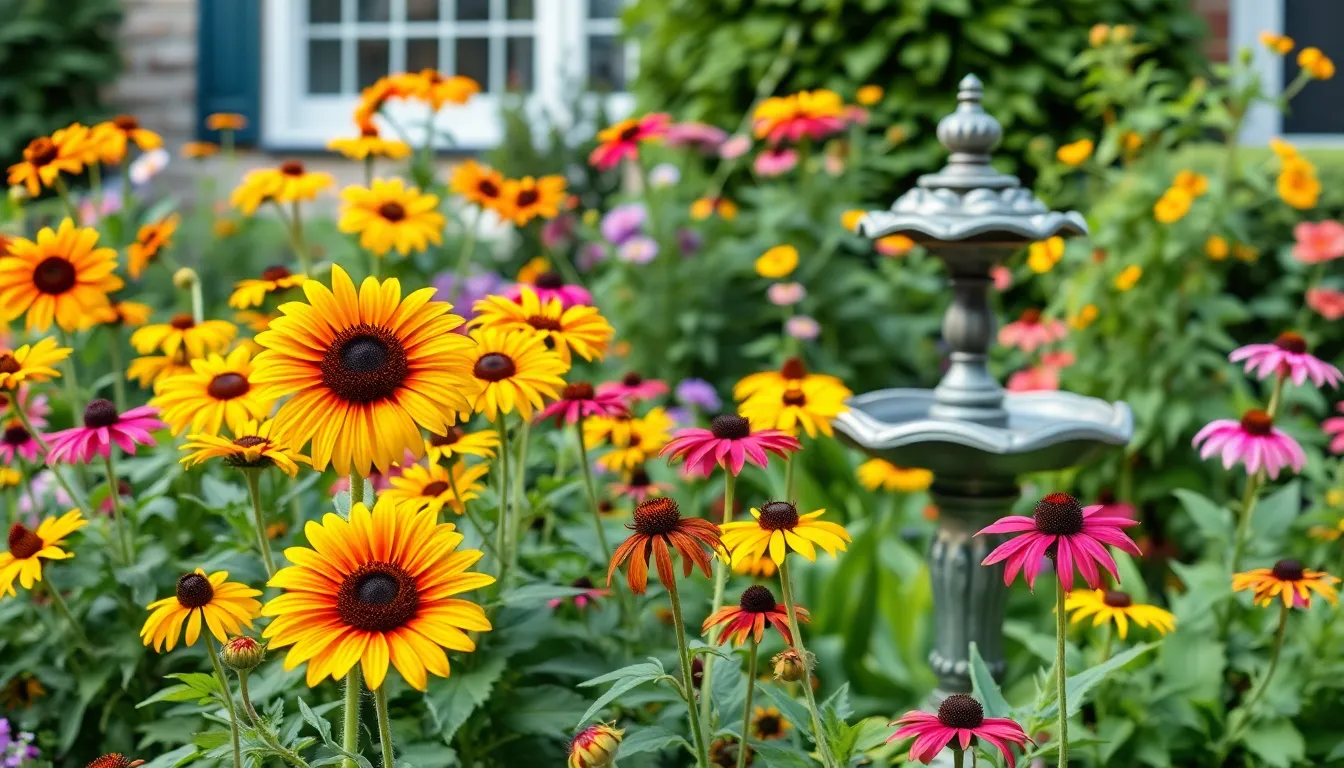
Wildlife-friendly flower gardens transform your front yard into a thriving network that supports local pollinators and beneficial insects. We’ll show you how to create beautiful flower displays that serve both aesthetic and ecological purposes.
Choose Pollinator-Attracting Native Flowers
Native flowers provide the most effective resources for local wildlife while requiring minimal maintenance in your front yard garden. We recommend selecting regionally adapted species that naturally thrive in your climate conditions and soil type.
Wild Sunflowers (Helianthus annuus) create stunning focal points with their bright yellow blooms that attract bees, butterflies, and birds. These hardy annuals reach heights of 3-10 feet and bloom continuously from summer through fall.
Black-eyed Susans (Rudbeckia hirta) offer vibrant golden petals with dark centers that pollinators find irresistible. These drought-tolerant perennials spread naturally to fill garden spaces and bloom from June through October.
Butterfly Weed (Asclepias tuberosa) produces clusters of bright orange flowers that monarch butterflies specifically seek for laying eggs. This native perennial grows 1-2 feet tall and provides both nectar for adults and host plants for caterpillars.
Lupines (Lupinus spp.) display tall spikes of purple, pink, or white flowers that attract long-tongued bees and hummingbirds. These nitrogen-fixing plants improve soil quality while creating dramatic vertical elements in your garden design.
| Native Flower | Bloom Period | Height | Primary Pollinators |
|---|---|---|---|
| Wild Sunflowers | Summer-Fall | 3-10 feet | Bees, Butterflies, Birds |
| Black-eyed Susans | June-October | 1-3 feet | Native Bees, Butterflies |
| Butterfly Weed | June-August | 1-2 feet | Monarch Butterflies |
| Lupines | Spring-Summer | 2-4 feet | Long-tongued Bees |
Create Habitat Features for Beneficial Insects
Habitat features beyond flowers provide essential shelter and breeding sites for beneficial insects that control garden pests naturally. We suggest incorporating diverse structural elements that support complete insect life cycles.
Trellises with climbing plants like honeysuckle and jasmine create vertical habitat layers that different insects prefer for nesting and foraging. These structures maximize garden space while providing year-round shelter options.
Water features or shallow ponds attract birds, beneficial insects, and other wildlife that need hydration sources. Small fountains or birdbaths work effectively in front yard settings and add soothing sounds to your outdoor space.
Rock piles and insect hotels offer protected spaces where beneficial insects overwinter and reproduce. Stack stones of varying sizes or create simple wooden structures filled with natural materials like bamboo tubes and pine cones.
Undisturbed soil areas between plantings allow ground-nesting bees to establish colonies that pollinate your flowers more effectively than imported honeybees. Leave small patches of bare, well-draining soil for these important native pollinators.
Plan Year-Round Food Sources
Year-round food sources ensure wildlife populations remain stable and continue supporting your garden’s network throughout all seasons. We recommend planning bloom schedules that provide continuous nectar, pollen, seeds, and berries.
Spring bloomers like early-flowering native bulbs and shrubs provide crucial food when pollinators first emerge from winter dormancy. Plant crocuses, wild lupines, and serviceberry to support hungry insects and birds.
Summer abundance comes from combining annuals and perennials that bloom in overlapping waves from June through August. Mix butterfly weed, black-eyed Susans, and native sunflowers for consistent nectar sources during peak pollinator activity.
Fall preparations include late-blooming asters, goldenrod, and seed-producing plants that help wildlife build energy reserves for winter. These plants also provide nesting materials and shelter as temperatures drop.
Winter sustenance comes from leaving seed heads standing and incorporating berry-producing native shrubs like elderberry and native roses. These food sources support overwintering birds and provide emergency nutrition during harsh weather periods.
Conclusion
Creating a stunning front yard flower garden doesn’t require extensive gardening experience or a massive budget. With the right planning and plant selection we can transform any front entrance into a welcoming showcase that boosts curb appeal and property value.
Whether we choose vibrant annuals for instant color cottage-style romance or sleek minimalist designs the key lies in selecting plants suited to our climate and maintenance preferences. From raised beds to container gardens and wildlife-friendly native plantings there’s a perfect approach for every home and lifestyle.
Our front yard garden becomes more than just landscaping—it’s an investment in our home’s beauty functionality and environmental impact. Start small choose plants we love and watch our front entrance flourish into the neighborhood’s most admired garden.
Frequently Asked Questions
What are the best annual flowers for creating instant curb appeal?
Fast-growing annuals like marigolds, zinnias, and petunias are excellent choices for instant impact. These flowers bloom continuously from spring through fall, providing vibrant color throughout the growing season. They’re easy to grow, budget-friendly, and create a welcoming entrance that enhances your home’s curb appeal immediately after planting.
How do I choose the right perennials for my climate?
Select native perennials adapted to your local climate conditions for the best results. In warm climates, consider hibiscus, birds of paradise, and orchids. For cooler regions, hydrangeas, azaleas, and coneflowers work well. Native plants require less water and maintenance while providing reliable blooms year after year.
What’s the ideal size for raised flower beds?
Optimal raised bed dimensions are 12 to 24 inches in height and 3 to 4 feet in width. This size allows for easy maintenance and access while providing adequate soil depth for healthy root development. The height improves drainage and soil quality, while the width ensures you can reach the center without stepping into the bed.
How can I ensure continuous blooms throughout the growing season?
Plan for seasonal color rotation by selecting plants with different blooming periods. Include spring bloomers like peonies and azaleas, summer bloomers such as coneflowers and black-eyed Susans, and fall bloomers like asters and chrysanthemums. Add evergreen plants for year-round structure and visual interest between flowering seasons.
What materials work best for raised flower beds?
Choose materials that complement your home’s architectural style. Wood offers a rustic appearance, stone or brick provides classic elegance, and concrete or composite blocks create a modern look. Ensure your chosen material is weather-resistant and includes proper drainage features to support healthy plant growth.
How do I create a low-maintenance cottage garden style?
Focus on traditional cottage flowers like roses, lavender, and coneflowers that attract pollinators and require minimal care. Use informal planting patterns with layered techniques and incorporate wildflower mixes. Add climbing plants like clematis for vertical interest. This relaxed approach creates romantic charm with less maintenance than formal gardens.
What defines a modern minimalist flower garden?
Minimalist gardens emphasize clean lines and simple forms using plants like ornamental grasses and succulents. Stick to monochromatic color schemes focusing on whites, purples, and greens. Limit plant varieties to three to five types and use geometric planting patterns with contemporary hardscape elements for a streamlined, sophisticated look.
Which containers work best for front yard flower displays?
Weather-resistant materials like cedar, fiberglass, metal, and stone offer durability and aesthetic appeal. Ensure containers have multiple drainage holes and consider elevating them for better air circulation. Choose sizes appropriate for your plant selections and coordinate colors with your home’s exterior for a cohesive appearance.
Can I include edible plants in my front yard flower garden?
Yes, incorporate safe-to-eat flowering plants like nasturtiums, oregano, rosemary, and runner bean blossoms. These plants enhance both aesthetic and culinary appeal while maintaining garden beauty. Plan accessible pathways for easy harvesting and integrate fruits and vegetables with ornamental flowers for year-round functionality and visual interest.
How do I create a wildlife-friendly flower garden?
Choose native flowers that attract pollinators, such as wild sunflowers, black-eyed Susans, butterfly weed, and lupines. Create habitat features like trellises, water sources, and rock piles. Plan a bloom schedule that provides continuous nectar, pollen, seeds, and berries throughout all seasons to support local wildlife year-round.

